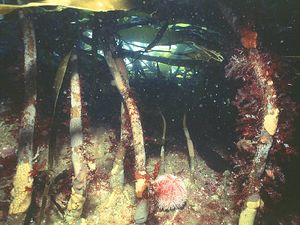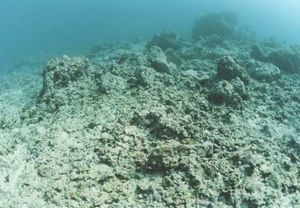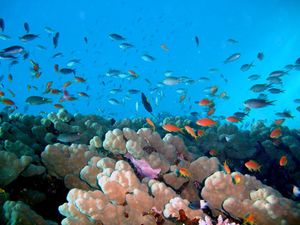Difference between revisions of "Habitat destruction and fragmentation"
| Line 18: | Line 18: | ||
There is a unique plant and animal diversity living in close association with specifics habitats or habitat forming species. For example, invertebrate assemblages associated with mussel beds, epiphytic and epibenthic assemblages communities living in kelp forests or fish communities associated with coral reefs. The risk of diversity loss associated with the destruction of these habitats has been estimated using several ecological models, e.g. species-area curves. However, in general it is predicted that the effect of habitat loss is likely to be synergistic, rather than the sum of the loss of individual species, because of the interaction between species leading to a chain of impacts <ref name = Beck/>. | There is a unique plant and animal diversity living in close association with specifics habitats or habitat forming species. For example, invertebrate assemblages associated with mussel beds, epiphytic and epibenthic assemblages communities living in kelp forests or fish communities associated with coral reefs. The risk of diversity loss associated with the destruction of these habitats has been estimated using several ecological models, e.g. species-area curves. However, in general it is predicted that the effect of habitat loss is likely to be synergistic, rather than the sum of the loss of individual species, because of the interaction between species leading to a chain of impacts <ref name = Beck/>. | ||
| − | [[image:Barren.jpg |thumb|right|Fig. | + | [[image:Barren.jpg |thumb|right|Fig. 2. The loss of habitats can lead to the formation of barren areas where only few species are able to survive. Photo © NOAA]] |
2) '''The loss of food resources.''' | 2) '''The loss of food resources.''' | ||
Revision as of 15:20, 18 March 2009
Habitat destruction and fragmentation is a process that describes the emergences of discontinuities (fragmentation) or the loss (destruction) of the environment inhabited by an organism. Marine ecosystems are experiencing high rates of habitat loss and degradation, and these processes are considered as the most critical threat to marine biodiversity [1]. It is estimated that every day between 1960 and 1995, a kilometer of coastline was developed, causing permanent losses of valuable habitats, such as coastal wetlands, seagrass meadows and rocky shores [2]. Approximately 20% of the world’s coral reefs were lost and an additional 20% degraded in the last several decades of the twentieth century, and approximately 35% of mangrove area was lost during this time[3].
Habitat can be defined as predominant features that create structural complexity in the environment, such as plants (e.g., seagrass meadows, kelp forests), or animals (e.g. Sabellaria reefs, burrowing fauna in sandflats).
Contents
Habitat loss and biodiversity
Researchers have identified three major components of habitat loss that relates to species diversity [4]:
1) The loss of resident species.
There is a unique plant and animal diversity living in close association with specifics habitats or habitat forming species. For example, invertebrate assemblages associated with mussel beds, epiphytic and epibenthic assemblages communities living in kelp forests or fish communities associated with coral reefs. The risk of diversity loss associated with the destruction of these habitats has been estimated using several ecological models, e.g. species-area curves. However, in general it is predicted that the effect of habitat loss is likely to be synergistic, rather than the sum of the loss of individual species, because of the interaction between species leading to a chain of impacts [2].
2) The loss of food resources.
Most biogenic habitats such as kelp forests, seagrass meadows, and other vegetated habitats and their associated organisms are known to be highly productive compared to structurally simpler habitats such as sandy habitats. They export a large amount of nutrients and particulate matter to coastal food webs either through direct transfer of animal biomass (i.e. predation, movements of individuals) or indirectly through dissolved and particulate organic. The loss of these food resources can negatively affect the productivity of individual species or communities, with more profound effects that are likely to propagate along food chains [2].
3) The loss of ecosystem functions provided by the habitat.
Structurally complex habitats provide a wide range of ecosystem functions to the environment including food and refuge provision for other species, trapping sediment, modifying light and hydrodynamic conditions, providing resilience to the system. When the habitats are lost this functions are lost with them [5][2]. For example, the replacement of macroalgal canopies by turfs affects sediment dynamics on rocky coasts, where fronds prevents accumulation of sediments while turfs tend to trap sediments even on exposed coasts
Effects of habitat loss on biodiversity
Habitat loss has been generally associated to drastic declines in overall abundance and diversity of marine organisms. For example, in the Wadden Sea, the destruction of biogenic habitats has caused the regional extinction of at least 26 species during the past 2000 years [6]. Similarly, the loss of seagrass meadows results in a reduction in the number of species and abundance of fishes. Generally, the environmental changes associated with the destruction of natural habitats promote the arrival and colonization of opportunistic species that can benefit from conditions in disturbed condition. One example is the expansion of opportunistic green ephemeral algae or turf forming algae following the destruction of removal of canopy forming species, such as kelp. Other species that can favor from disturbed habitats condition are alien species. Once alien species are established they can contribute further to reduce local diversity by interacting with native species.
Human activities as driver of habitat loss
Some anthropogenic activities responsible for habitat destruction include the construction of coastal protection, land reclamation, aggregate (sand and gravel) extraction, recreation and developments including ports, harbours and industries. Additionally, the growing number of tourists presents a significant threat to many coastal habitats in Europe, which can disturb by trampling or direct harvesting. In offshore waters, exploration and development of oil and gas activities threaten marine habitats, mainly with discharges of oil and other pollutants. Physical damage to marine habitats can result from fishing activities such as bottom trawling. Deep-water trawlers use heavy rock-hopping equipment, which has been reported to cause long-term to seabed habitats such as cold-water coral reefs in Norwegian, Scottish and Irish waters.
Implications for conservation and management
Habitat loss leads to significant changes in species diversity species, community composition and structure, and ecosystem functioning. Conservation efforts of coastal and marine habitats have been driven in part by the effects of habitat loss on declines in species richness. However, looking at the effect of habitats loss on species richness is not sufficient. To comprehensively inform management actions, we must also understand how habitat loss affects all components of species diversity and the ecosystem functions and services that diversity provides across all four major classes:
- regulating services such as shoreline buffering from storms
- provisioning services such as fish production
- cultural services such as tourism
- supporting services such as primary production[7].
There is an urgent need for the implementation of long-term and large scale monitoring programs of changes to marine habitats and species distributions. This monitoring should be coupled with studies designed to treat management actions that result in habitat loss as large-scale experiments. For example, the use of marine protected areas (MPAs) and marine reserves as tools to underpinned the relationships between the functionality of habitats and the distribution and abundance of target taxa. According to the Global Biodiversity Asessment [8] the most effective way to conserve biodiversity, by almost any reckoning is to prevent the conversion or degradation of habitat.
One important aspect that also needs to be considered is habitat restoration. On land there is a long tradition of restoring habitats, such as mining waste tips. There are some examples of habitat restoration in the marine environment, such as the well-publicized clean-up of the River Thames in the UK where salmon can now be found in London. The developing science of restoration ecology should be a part of a strategy for conservation of coastal biodiversity.
References
- ↑ Gray, J.s. 1997. Marine biodiversity: patterns, threats and conservation needs. Biodiversity and Conservation 6, 153-175
- ↑ 2.0 2.1 2.2 2.3 Airoldi, L., Beck, W.M. 2007. Loss, status and trends for coastal marine habitats of Europe. Oceanogr. Marine Biology Annual Review 45, 345–405.
- ↑ Millennium Ecosystem Assessment, 2005. Ecosystems and Human Well-being: Synthesis. Island Press, Washington, DC
- ↑ Airoldi, L., Balata, D., Beck, M.W. 2008. The Gray Zone: Relationships between habitat loss and marine diversity and their applications in conservation. Journal of Experimental Marine Biology and Ecology 366, 8-15.
- ↑ Dobson, A., Lodge, D., Alder, J., Cumming, G.S., Keymer, J., Mcglade, J., Mooney, H., Rusak, J.A., Sala, O., Wolters, V., Wall, D., Winfree, R., Xenopoulos, M.A. 2006. Habitat loss, trophic collapse, and the decline of ecosystem services. Ecology 87, 1915–1924.
- ↑ Wolff, W.J. 2000. Causes of extirpations in the Wadden Sea, an estuarine area in the Netherlands. Conservation Biology. 14, 876–885.
- ↑ Millennium Ecosystem Assessment, 2005. Ecosystems and Human Well-being: Synthesis. Island Press, Washington, DC
- ↑ Heywood, V.H. (ed) 1995. The Global Biodiversity Assessment. United Nations Environment Programme. Cambridge University Press, Cambridge. 1140 pp.
Please note that others may also have edited the contents of this article.
|



